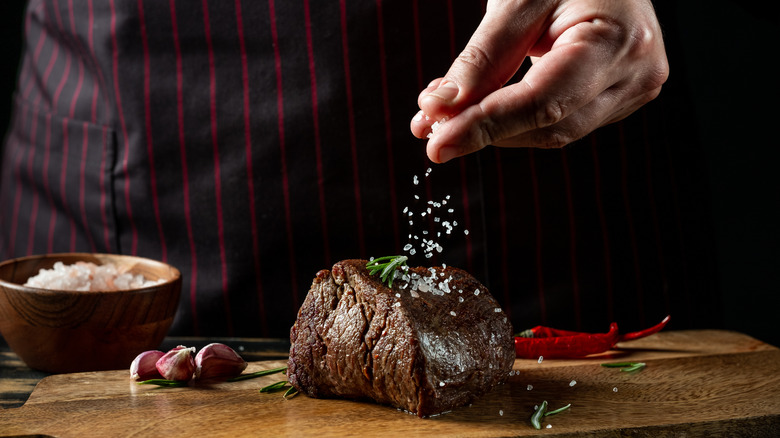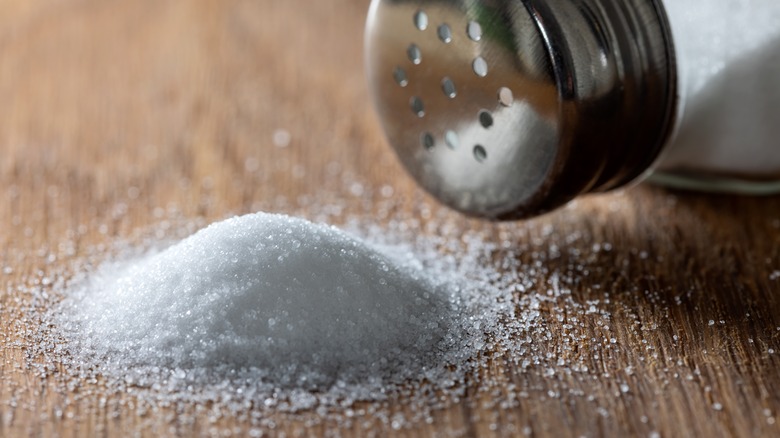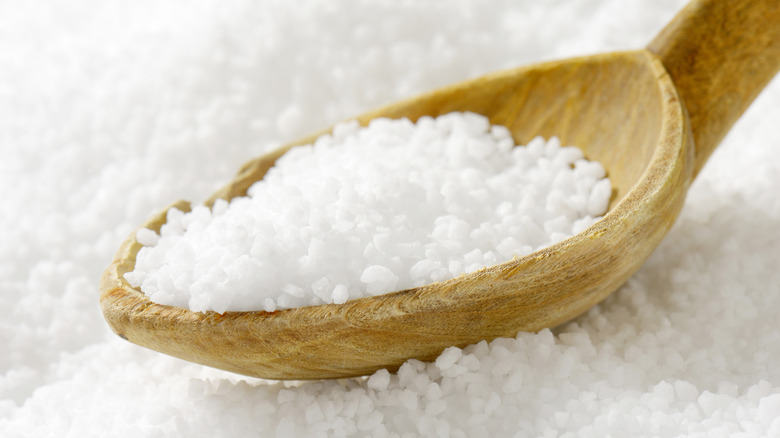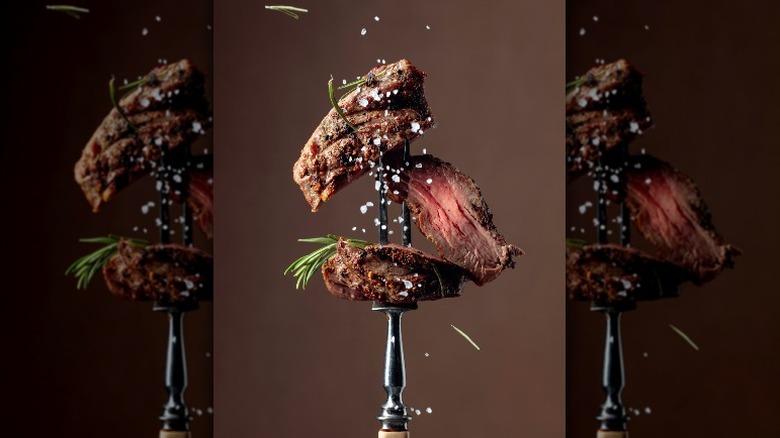Why You Shouldn't Use Table Salt To Season Steaks
If seasonings were royally ranked, salt would reign supreme. The mineral has been seated comfortably on the culinary throne for as long as kitchens have been around, improving our foods for millennia running. This earthly compound has assumed important roles throughout history and is a revered ingredient that can make or break a simple or gourmet meal.
Time notes that salt was discovered when animals led early peoples to natural salt deposits. As we evolved, humans began to understand and value it as a flavor enhancer and essential mineral in our diets and as a food preservative and antiseptic. Before it was widely harvested, salt was used as currency and traded on a level equal to gold.
Although salt is now a cheap commodity, it retains its cherished status because it's useful and draws out the flavor of essentially all foods. Science Focus states that salt directly impacts the entire range of tastes our palette can detect — sweet, bitter, umami, and sour. A pinch of salt in a sweet treat will reduce bitter flavors and sharpen sugary flavors, while a heftier measure will enhance savory flavors. When seasoning a juicy steak, we want umami flavors forward, and there's an ideal type of salt for the job.
Leave granulated salt in the shaker
There's a good reason granulated salt is in your rugalach, and not your rib eye. According to MasterClass, table salt is refined by rinsing raw salt, purging it of its natural minerals, and then drying it in a controlled environment that produces small, uniform grains. Some granulated salt contains additives like iodine, which can impart a metallic flavor, and anti-caking agents that separate the fine grains. But this variety of salt proves useful in baked goods because the small granules will distribute more evenly than rougher salts, creating a more consistent chemical reaction.
Of all the varieties of salts on the market, granulated salt imparts the most potent flavor because of its weight-to-volume ratio. Its small granules pack tighter and, when measured out, are heavier than other varieties, coming in at 19 grams per tablespoon compared to sea salt's 15 grams. Also, its dense crystalline structure causes it to dissolve slower than flaky or coarse-grain salts, making it an excellent option for things like brining, which requires a long-lasting, strong dose of salty flavor.
Beef is all about flavor, and imparting an additive-filled salt with a metallic taste is a good way to ruin an expensive New York strip. Because a pinch of granulated salt feels smaller in the hand than a coarse variety, it would be all too easy to over-salt your food. Reserve table salt for sourdough, but choose a different salt for your steak.
A happy medium
When you are treating yourself to a quality steak, it must be seasoned perfectly to enhance beef's complex savory flavors and textures. According to Lean and Tender Beef, salting steak releases the natural juices by pulling them to the surface, where they mingle with the seasoning before being reabsorbed into the cut. When the salt is absorbed, the protein structures break down, which has the effect of tenderizing the meat.
When choosing the right salt to season your steak, Food & Wine suggests opting for a Goldielocks-sized granule that's larger than table salt but isn't as coarse and chunky as finishing salt. A medium-grain variety like Kosher salt or sea salt is just right. It has a heftier hand feel that makes it easy to pinch and sprinkle without overdoing it, and its larger crystal structure allows it to dissolve into your steak at an ideal rate.
Salting tips
Aside from choosing a medium grain salt, there are a few seasoning tips that will ensure a flavorful and tender steak with a mouthwatering crust every time. Weight matters when salting, so if you're apprehensive about using your fingers to measure, Taste of Home recommends using a scale to get the right amount.
Once you've properly seasoned your steak (sides included), you'll want to give your cut of beef enough countertop time to reach room temperature while the salt does its thing. Food & Wine notes that rushing the salting process draws the meat's moisture out but doesn't allow the seasoned juices to reabsorb.
When you're ready to sear, lightly pat your steak with a paper towel, as a dry surface creates the deep golden crust that every steak lover deserves. Also, be sure to let your steak rest after achieving salty seared perfection to allow hot juices to return to the meat. The Spruce Eats recommends you let it rest for as long as it took to cook it, or about five minutes per inch of thickness.
Once it's rested, you can bust out a coarse grain finishing or a flavored salt to add an additional layer of salty flavor to your steak. The large pyramid shape of Maldon salt looks appealing and adds a salty crunch to sliced beef, or a gourmet smoked salt can be used to add yet another flavor layer to your well-seasoned steak.



